從廢墟到文化寓所:左營郭家古厝的蛻變之旅
From Ruins to Cultural Haven: The Transformation Journey of Zuoying Guo Family Ancient House
文、攝影/王詩晴
下午來到店仔頂街巷內郭家古厝時,平時緊閉的大門今天居然大開,這真是個幸運的巧合。今天的天氣格外宜人,陽光透過盆栽樹影灑在門口木式「左營蓮潭郭家百年古厝」招牌上,微風輕拂著老屋常見的磨石子牆面,帶來陣陣清涼。薛大姊在大門口發現我們在拍照,她友善地招呼我們進入,熱情地歡迎我們參觀郭家古厝。進入大門後,微風帶來陣陣古厝的歷史氣息,仿彿走進了另一個時空,呼吸之間增添了一份愉悅和舒適的氛圍。薛大姊補充因為這裡有經營民宿,為了住客隱私則門戶緊閉不接待外客導覽,今逢假日恰好沒有住客,不禁讚嘆彷彿是命中註定,讓這次的訪談更加難得而特別。
In the afternoon, when we arrived at Guo Family ancient house nestled within the lanes of Dianzaiding Street, the usually tightly closed gates were unexpectedly wide open today – a truly fortunate coincidence. The weather was exceptionally pleasant, with sunlight filtering through the shadows of potted trees and casting a gentle glow on the wooden sign that read 'Zuoying Liantan Guo Family Century-Old Ancient House.' A light breeze delicately brushed against the familiar cobblestone walls of the old house, bringing a refreshing coolness. Ms.Xue noticed us taking photos at the entrance, and she kindly beckoned us inside, warmly welcoming us to explore the Guo Family Ancient House. Upon entering the gates, a gentle breeze carried with it the historical essence of the old residence, creating an atmosphere that felt like stepping into another dimension. In each breath, there was an added sense of joy and comfort. Ms.Xue added that they operate a bed-and-breakfast here, usually keeping the gates closed to ensure guest privacy. However, on this holiday with no guests around, she couldn't help but marvel at the seemingly destined timing, making this interview even more rare and special.
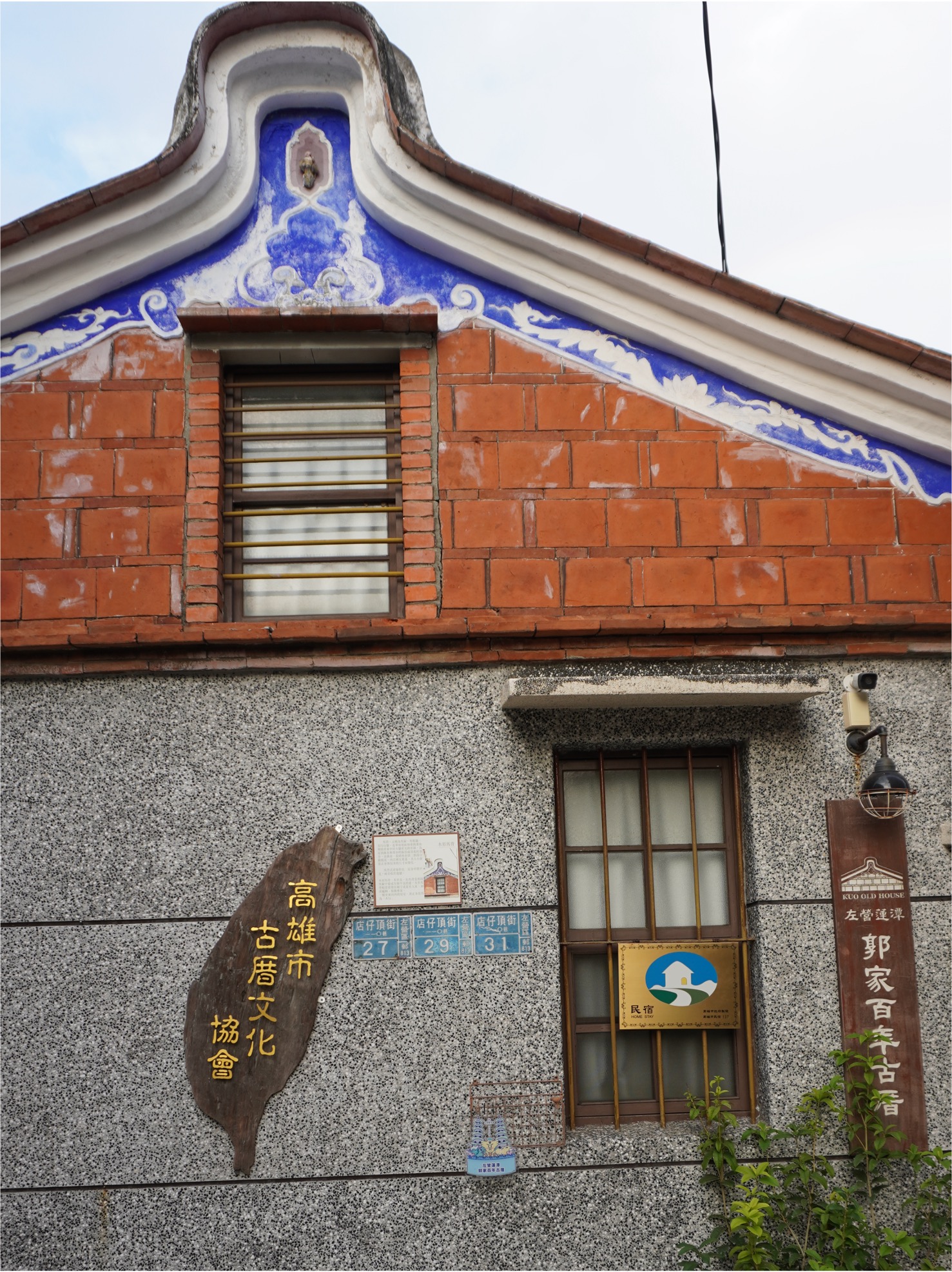
左營蓮潭郭家百年古厝
Guo Family Ancient House in Zouying
薛大姊是郭家古厝的管理者,本身也生於左營地區,對於這片土地的興盛和凋零有著很多感想。薛大姊站在古厝大廳前庭院,望著建築天空遠方,她的眼神中閃爍著對這座宅邸悠久歷史的深厚情感。這次的訪談是保留左營地區眷村故事的一部分,而薛大姊成為了這段歷史的見證者。
Ms.Xue is the manager of the Guo ancient house, born and raised in the Zuoying area. She has a deep connection to the prosperity and decline of this land. Standing in the courtyard in front of the house’s main hall, Ms.Xue gazes towards the distant sky, her eyes shimmering with profound emotions for the enduring history of this mansion. This interview captures a part of the stories of the military dependents' village in the Zuoying area, with Ms.Xue becoming a witness to this history.
「這片土地曾經因為老宅的荒廢而悄悄轉變成了廢墟,家族曾打算賣掉,可這念頭持續多時,卻乏人問津。」薛大姊回憶道,「直到八年前,郭家的後代,也就是現任古厝文化協會理事長的郭進吉先生,做了一個令人動容的夢。」她繼續說明,「郭進吉夢見祖先在上空盤旋,找不到回家的路。夢醒後他追問意義,才得知長輩不願賣掉這片土地。這個夢成了重新評估古厝命運的轉捩點。」
"This land once quietly transformed into ruins due to the abandonment of the old house. The family had considered selling it, but this idea lingered without attracting any interest," reminisced Ms.Xue. "It wasn't until eight years ago when Mr.Guo Jinji, the current Chairman of the Ancient House Cultural Association and a descendant of the Guo family, had a touching dream," she continued. "In the dream, ancestors hovered above, unable to find their way home. Upon waking, he inquired about its meaning and learned that the elders were unwilling to sell this piece of land. This dream became a turning point in reevaluating the fate of the ancient house.
在家族內部討論之後,郭家決定重新整理古厝,而此時意外的幸運降臨。薛大姊解釋道:「那時候,郭家剛好有另一片土地在新莊仔路,原本是畸零地難以脫手,但卻有建商願意以五、六百萬的價格購買。這筆意外之財成為了整理古厝的資金來源,他們認為這是祖先賜予的機會,要處理老宅的問題。」
After discussions within the family, the Guo family decided to refurbish the house, and an unexpected stroke of luck ensued. Sister Xue explained, "At that time, the Guo family happened to have another piece of land on Xin Zhuangzai Road. Originally considered a difficult piece of land to deal with, a developer expressed interest in purchasing it for five to six million. This unexpected windfall became the source of funds for renovating the historic residence, and they saw it as an opportunity granted by their ancestors to address the issues with the old house."
「在家族的努力下,這片土地經過重新整理,不再是廢墟,而是蛻變成了一個古色古香的寓所。」薛大姊的聲音中充滿了對家族毅力的讚歎。
"With the family's efforts, this land underwent a thorough renovation and transformed from ruins into a charming cultural haven," Ms. Xue's voice brimmed with admiration for the family's perseverance.
她繼續描述著轉型經營的過程,「後來,我們想,既然要整修,那就讓這片古厝轉型成一間溫馨的民宿吧!經過精心規劃和設計,每個房間花費了一百萬的成本進行裝修。」
She continued describing the process of transitioning to a new business model, saying, "Later, we thought, since we're renovating, let's transform this ancient house into a cozy bed-and-breakfast! After careful planning and design, each room underwent renovations costing a million ."
目前郭家古厝擁有七個房間,其中六個房間供應給住宿的旅客使用,每一間房間都經過精心裝修,展現出濃厚的歷史風格和現代舒適感。另外一間房間作為備品空間,用來存放民宿所需的備品和日常用品。這些房間提供給來訪的客人,讓他們在古厝中品味悠久歷史的同時,也享受到愜意的居住體驗。
Currently, the Guo Family ancient house has seven rooms, with six dedicated to accommodating guests. Each room has been meticulously renovated to showcase a rich historical style while providing modern comfort. The remaining room serves as a storage space for the necessary items and daily supplies of the bed-and-breakfast. These rooms are offered to visiting guests, allowing them to savor the deep-rooted history of the house while enjoying a delightful living experience.
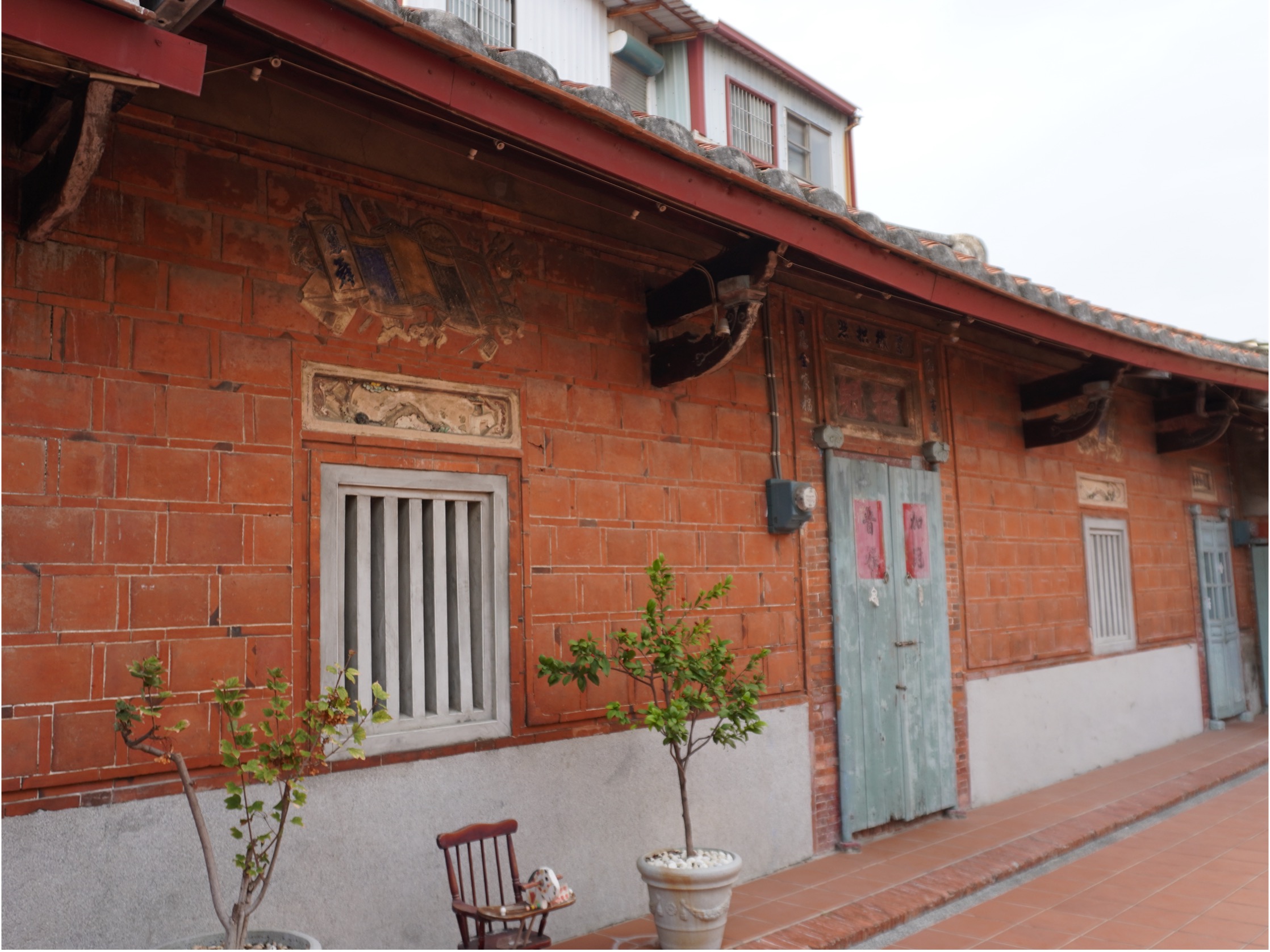
古厝內院
inside Guo Family Ancient House
薛大姊的目光穿越著歷史的迷霧,這座厝最早建造於1909年,當時為七開間、兩伸手的傳統建築,正廳前往下分成上埕和下埕的三合院格局,後代將建地建物變更,不同的產權也只好將出入口改到巷內。郭家以務農為主,將農穫就載回自家的埕內。在古厝一旁還有簡單的農具,提供導覽說故事,最特別的是往上開門的鳥籠,廖大姊笑說這是古時候的「帶路雞」用,現在已不復見。
Ms.Xue's gaze pierces through the historical mist. Judging from the door frame details and construction techniques, it seems to have been crafted by the same artisan." Originally a traditional structure with seven open rooms and two extended wings, the main hall was divided into upper and lower sections forming a courtyard in the layout of a Sanheyuan. However, due to changes in property rights and subsequent alterations to the building and land, the entrance had to be moved to the lane. The Guo family, primarily engaged in farming, would bring their harvest back to their courtyard. Simple agricultural tools are displayed beside the house, serving as visual aids for guided storytelling. Of particular note is the birdcage hanging from above, which Ms.Xue humorously mentions as the ancient version of a "guide chicken," a sight now rarely seen in modern times.
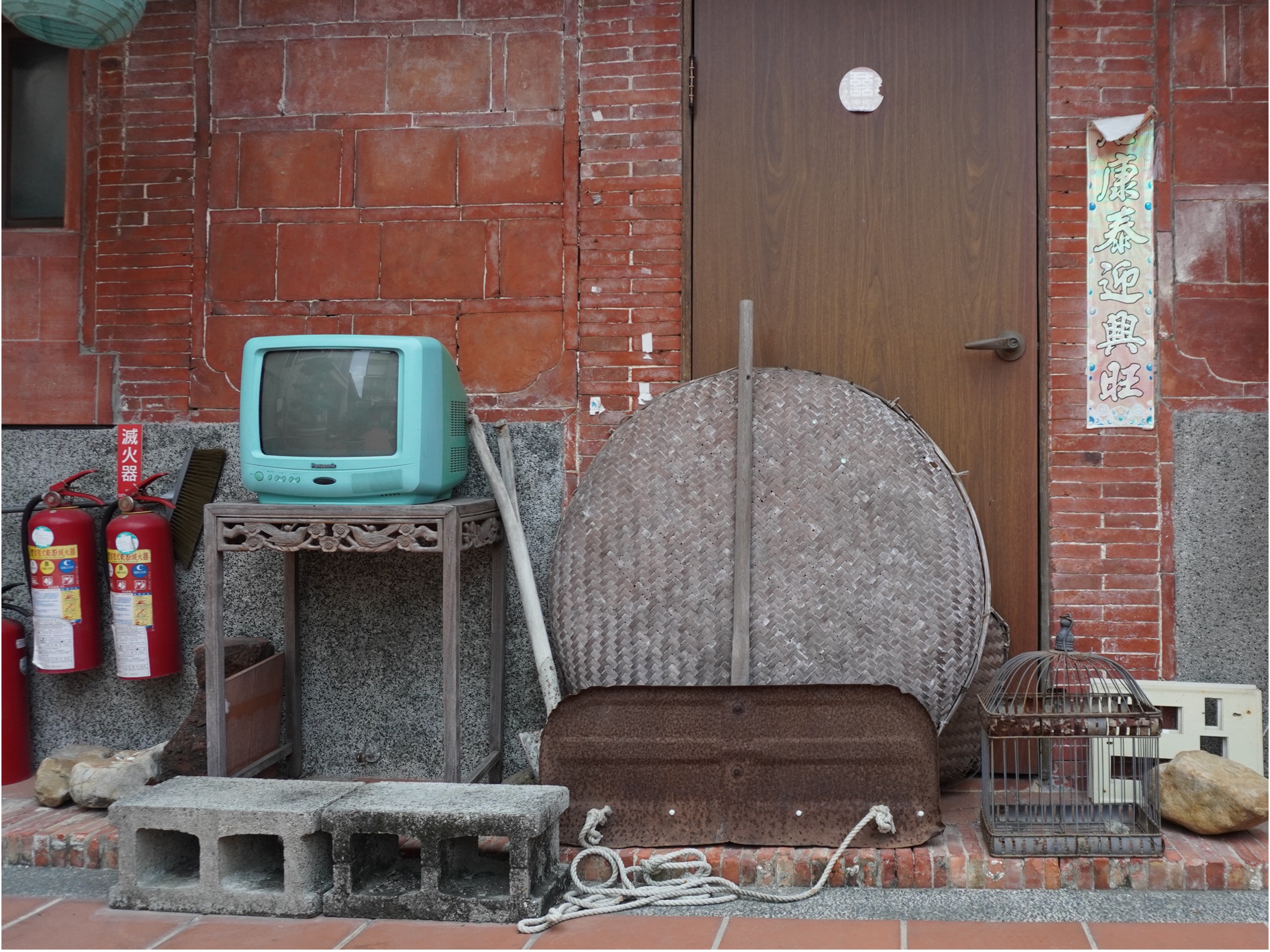
簡單的農具與「帶路雞」
Farm tools and "guide chicken"
她指著屋頂上的木頭,「這些木雕可都是匠人們花了好些心思雕琢的,是當年的匠人精湛技藝的代表,顯見這座宅邸在當時的經濟狀況,好的材料才能保留百年到現在還這麼堅固。」出履起的關刀栱意在出武狀元,不過圖案已經模糊,即便時光漸逝,但其豐富的歷史意涵仍隨著磚瓦間傳承。內埕有萬字紅磚壁面,屋頂有避風作用的柳條磚,正如窗楣書卷上斑駁看不清字的龍飛與鳳舞,敘說著一個家族的興衰軌跡。
She points to the wooden carvings on the roof, "These wood carvings were meticulously crafted by artisans, representing the superb skills of craftsmen from that era. It's evident that the economic condition at the time allowed for the use of high-quality materials, ensuring the durability of this mansion for over a century. "The raised ridge on the roof, shaped like an unveiled ancient Chinese sword, was originally intended to symbolize martial excellence. Though the patterns have faded over time, the rich historical significance endures, passed down through the bricks and tiles. In the courtyard, there are walls made of red bricks with the character "Wan" The roof is covered with willow-shaped tiles that serve as windbreakers. Like the dragon and phoenix depicted on the window lintel's scroll, their characters now worn and indecipherable, they narrate the rise and fall of a family's fortunes.
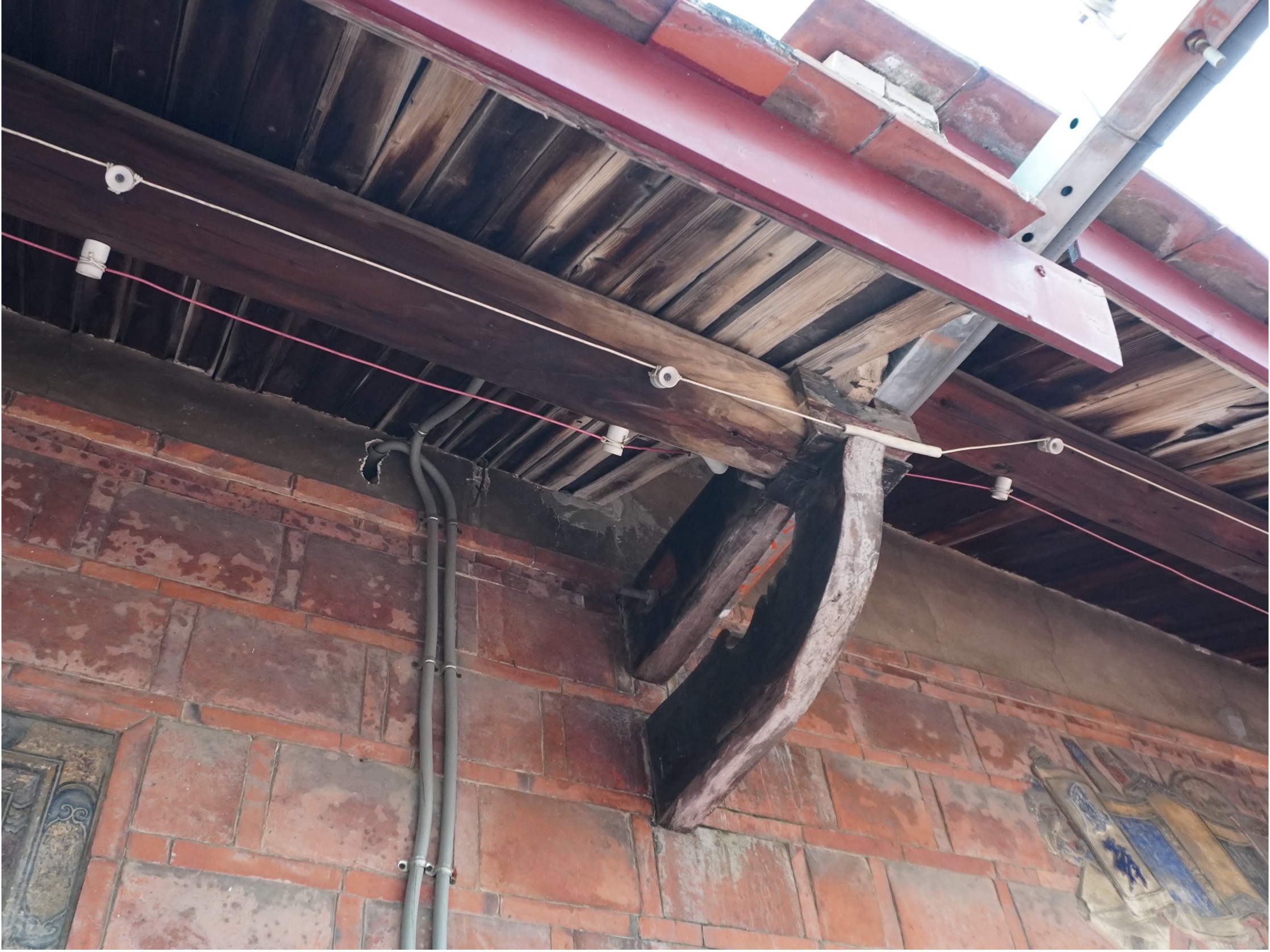
懸樑與木雕
The wood carvings
由於其他房間作為民宿使用不便進入,薛大姊特地打開正廳的大門,邀請我們參觀。這裡擺放著許多老物件,像是古老的家具、玩具、衣服等,平常這個被用來舉辦抓周活動,同時為學校和民眾提供一個寶貴的歷史文化推廣場所。談話間我眼尖看到管理室地上的孔蓋,廖大姊笑說我的觀察力敏銳,這是當年因應二戰當時頻繁的空襲,提供自家人使用的防空洞,原本庭院內設有三處,後來整修僅保留這個最小的防空洞,提供參觀遊客見證當時的烽火年代,廖大姊示意我可以下去參觀,我掀起上面的厚重玻璃順著幾層階梯往下看,大概才一兩坪大小,高度不高無法讓人在底下站立,每一處都散發著濃厚說不完的歷史故事。
As accessing other rooms used for the bed-and-breakfast was inconvenient, Ms.Xue specifically opened the main hall's door to invite us for a tour. Numerous antique items, such as old furniture, toys, and clothing, are displayed here. Normally used for the traditional Chinese baby celebration activity, it also serves as a valuable historical and cultural promotion space for schools and the public. During our conversation, I noticed a floor opening in the management room. Sister Xue chuckled, acknowledging my keen observation, and explained that it was an air-raid shelter built during World War II to protect their family during frequent air raids. Originally, there were three shelters in the courtyard, but during renovations, only the smallest one was preserved. Mr.Xue gestured for me to go down and explore. Lifting the heavy glass cover, I descended a few steps to see an area of roughly one to two square meters. The limited height didn't allow standing, but every corner exuded an abundance of untold historical stories, witnessing the tumultuous times of wartime.
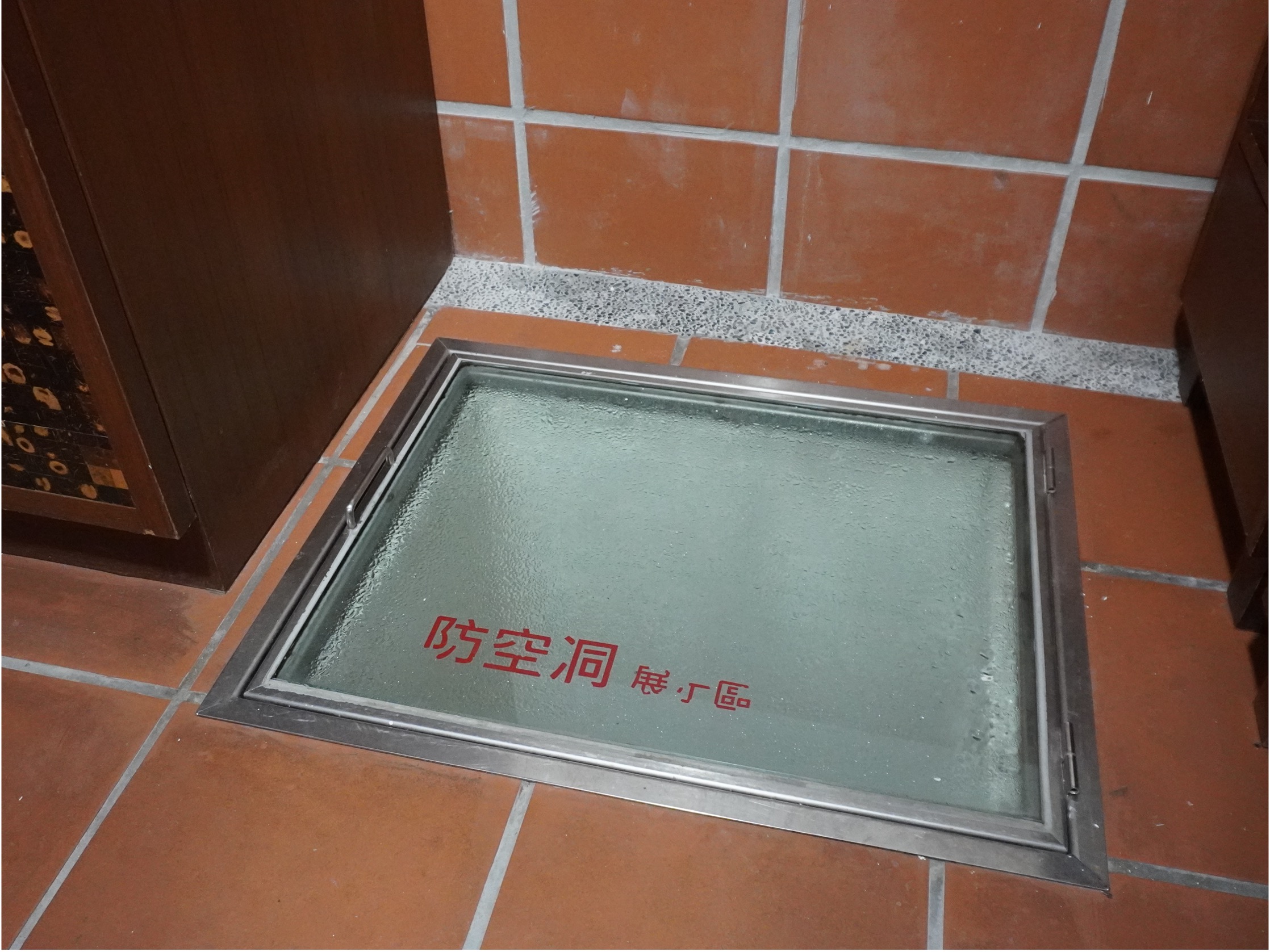
防空洞
Air-raid shelter
隨著薛大姊的話語,我們在謝家古厝中穿梭,感受努力和堅持才能讓文化得以延續。「保存古厝不是一個簡單的事情,需要家族成員的共同努力。屋主委託物業管理,雖定期進行維修和保養工作。但是一間房間一晚收租兩千,難以確保古厝得到妥善的保存和管理,仍需要推廣和活動辦理。」薛大姊的語氣中帶著對這座宅邸的責任和使命。
As Ms.Xue spoke, we navigated through the Xie Family Ancient House, experiencing the effort and perseverance required to preserve culture. "Preserving a historic residence is not a simple matter; it requires the collective effort of family members. While the owner entrusts property management for regular maintenance, renting out a room for two thousand a night makes it challenging to ensure the proper preservation and management of the historic residence. Promotion and events are still necessary," Ms.Xue's tone carried a sense of responsibility and mission towards the mansion.
我問薛大姊本身也是左營地區的大姓,面對自己家族的傳承有沒有可以分享的,「左營舊城姓氏多為郭、謝、黃、曾等,包括自己的薛家,以前人為了生活要溫飽,哪裡像現在懂得要文化保存,現在可以幫忙多多推廣,希望多一點人進來感受以前人的生活方式,想像古時候的生存也很不容易,這邊過去都是土角厝,有錢了才會有蓋磚房有大院子,要整個家族一起努力。」薛大姊的語氣中帶著對過去回憶的感慨,讓整個訪談充滿深層次的思考。
I asked Ms.Xue, being from a prominent family in the Zuoying area herself, if she had any insights to share about her family's heritage. She responded, "Surnames in the old Zuoying area include Guo, Xie, Huang, Zeng, and others, including my own Xue family. In the past, people focused on securing their livelihoods. Unlike today, they didn't understand the importance of cultural preservation. Now, we can contribute more to promotion. I hope more people come in to experience the lifestyle of the past and imagine how challenging survival was back then. In the past, these houses were mostly earthen buildings. It was only when families had the means that they could afford brick houses with spacious courtyards. The whole family had to work together." Ms.Xue's tone carried a nostalgic sentiment, infusing the entire interview with profound reflections.
最後我們留下愉快的合影,離開的時候我回頭看,巷內古厝的外牆雖然看起來是紅磚建造的,但是在當年能以紅磚建造的屋舍其實不多,大多都是土角厝,這在入口的地方還有保留一部分的見證。這趟訪談,讓我深入了解了這座古老宅邸的建築特色和保存工作,不光是人力還要財力,每一天的生活都是歷史的累積,是孕育我們成長的根,這次穿越時光的旅程,讓我們感受到了這片土地的厚重和謝家古厝所承載的豐富文化底蘊。
We concluded with a cheerful group photo. As I glanced back before leaving, the exterior walls of the ancient House in the lane, though appearing to be constructed with red bricks, revealed that not many buildings from that era were made of bricks. Most were earthen buildings, and a preserved section near the entrance testified to this fact. This interview provided me with a deep understanding of the architectural features and preservation efforts of this ancient mansion. Life, every day, is an accumulation of history, and our roots are nurtured by it. This journey through time allowed us to feel the weight of the land and appreciate the rich cultural heritage carried by the Xie Family ancient house.
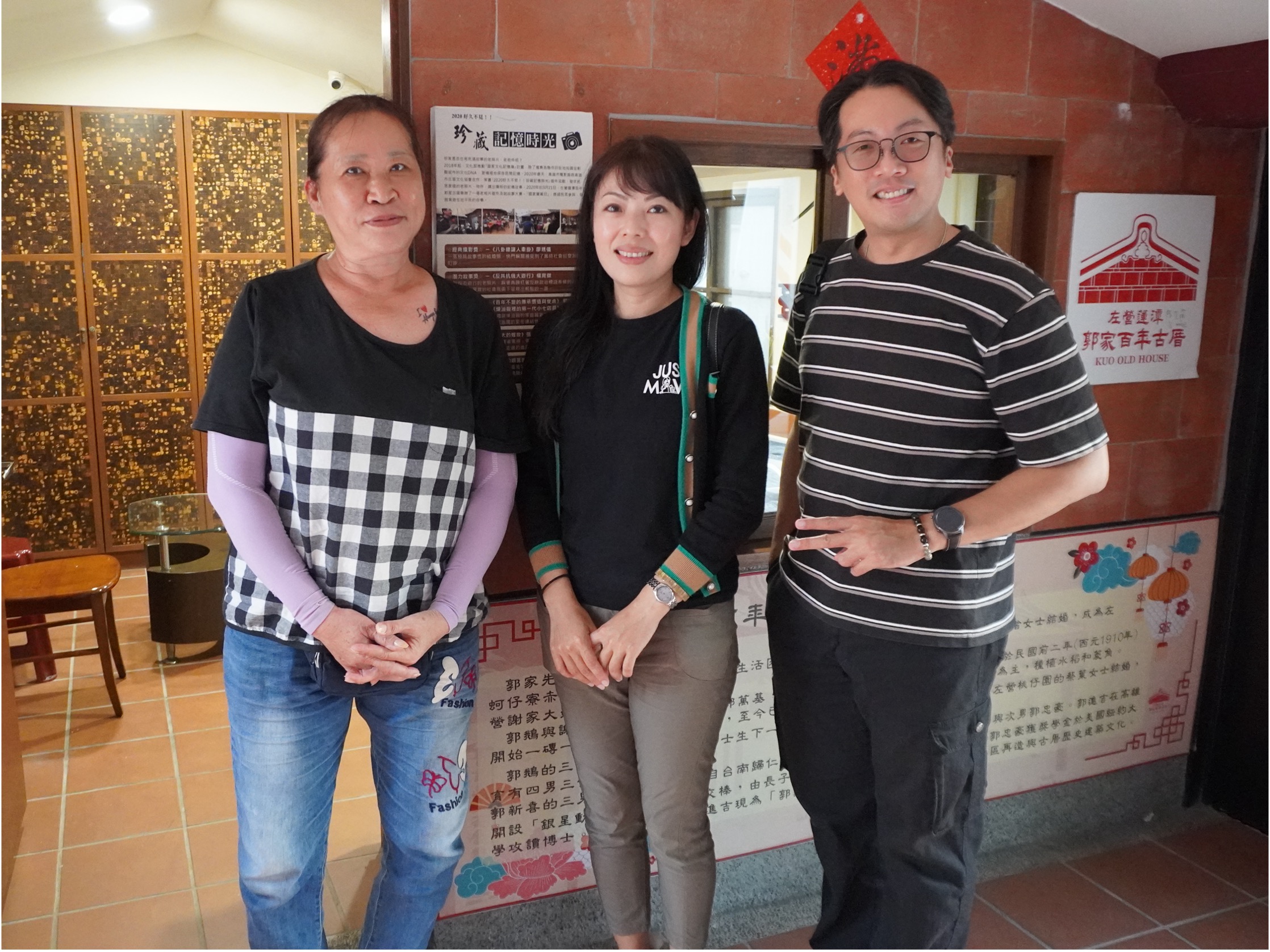
作者與薛大姐的合影
Author took photos with the owner of Guo Family Ancient House
